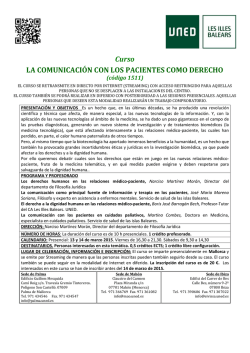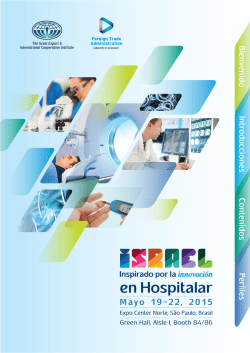
el pensamiento narrativo para contrarrestar las
EL PENSAMIENTO NARRATIVO PARA CONTRARRESTAR LAS ENFERMEDADES CARDIOVASCULARES. PRIMEROS RESULTADOS DE UN CAMINO DE PREVENCIÓN SECUNDARIA. NARRATIVE THINKING TO COUNTERACT CARDIOVASCULAR DISEASES. FIRST RESULTS IN A SECONDARY PREVENTION PATH. Loredana La Vecchia, Roberto Ferrari, Gabriele Guardigli y Andrea Fiorences Università degli Studi di Ferrara – Italia Abstract Background The act of narrating has historically always been present in medical practice. For example, think about Greek medical science. It was based on the doctor-patient relationship and this relationship, in turn, was based on the concept of philia (friendship), concept that extended to the inclusion of the agàpe (affection) (Cosmacini, 1985). In the temples devoted to Asclepius, solidarity accompanied every therapy, following a philanthropic idea of medicine: the iatros agathòs (the good doctor) experienced love for his art but, above all, he was interested in the man. The advent of rationalistic medicine has completely changed the meaning of the medical act, reducing the listening to the patient to a simple informative action (useful to elaborate a diagnosis). Nevertheless, lately, a renewed interest towards epistemological outcomes of a social nature has arisen, and approaches and methodologies – the medical humanitas – based on the knowledge of the person have born (Hunter, 1991; Charon, 2000; Evans, 2002). Method The work is of a qualitative-hermeneutic type. Results First results showed interest from the patients and multiple visions of the concepts of disease, health and prevention emerge from their stories. Conclusions The adoption of “narrative thinking” helps improving the doctor-patient relationship, and we believe that this could ease the adhesion to programs of health prevention in general. Key words: narrative, cardiovascular disease, prevention, doctor-patient relationship. Resumen Antecedentes El acto de narrar ha estado siempre presente en la práctica médica. Cabe recordar, por ejemplo, la medicina griega, que se basaba en la relación médico-paciente. Y esa relación se fundaba a su vez en el concepto de philia (la amistad), concepto que se extendía hasta incluir el agàpe (el afecto) (Cosmacini, 2008). En los templos dedicados a Asclepio, la solidaridad acompañaba cada acto de cura, según una idea filantrópica de medicina: el iatros agathòs (el buen médico) sentía amor por su arte, pero, sobre todo, interés por el hombre. El advenimiento de la medicina racionalista ha cambiado completamente el significado del acto médico, al reducir a simple acción informativa (útil en la elaboración de la diagnosis) la escucha del enfermo. Sin embargo, en tiempos recientes, se ha asistido al surgimiento de un renombrado interés hacia posturas epistémicas de carácter social, y en consecuencia al nacimiento de enfoques y metodologías basados en el conocimiento de la persona, la llamada medical humanitas (Hunter, 1991; Charon, 2000; Evans, 2002). Método El trabajo es de tipo cualitativo-hermenéutico. Resultados Los primeros resultados demuestran un interés por parte de los pacientes y, de sus historias, emergen visiones múltiples de los conceptos de enfermedad, salud, prevención. Conclusiones La adopción del “pensamiento narrativo” permite mejorar la relación médico-paciente. Creemos que esto puede facilitar, en general, la adhesión a los programas de prevención de la salud. Palabras clave: narración, enfermedades cardiovasculares, prevención, relación médico-paciente.
© Copyright 2025






